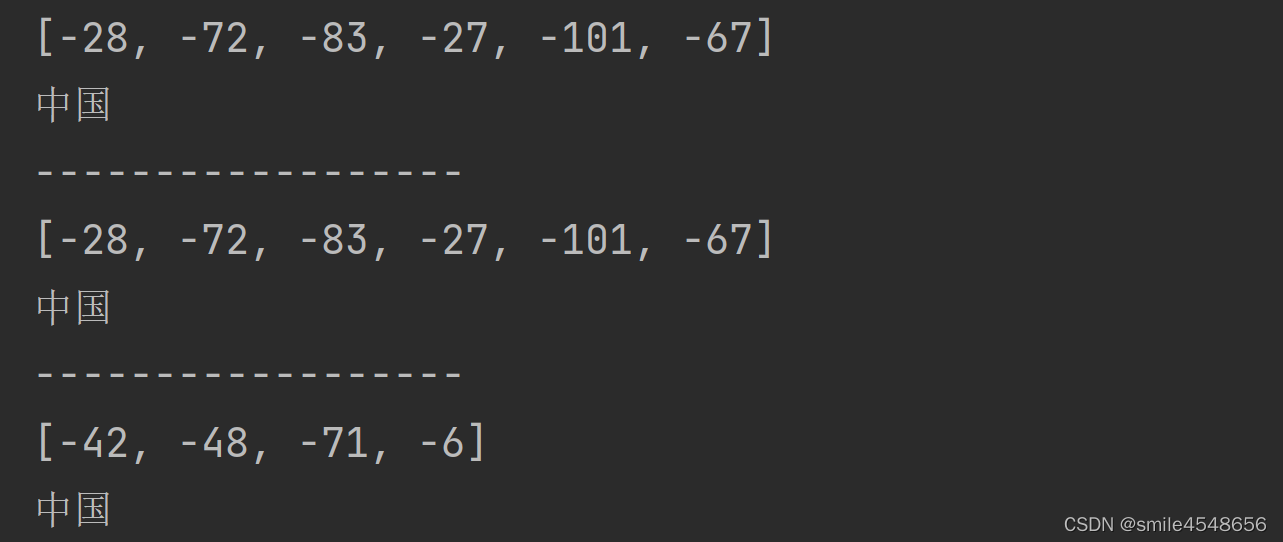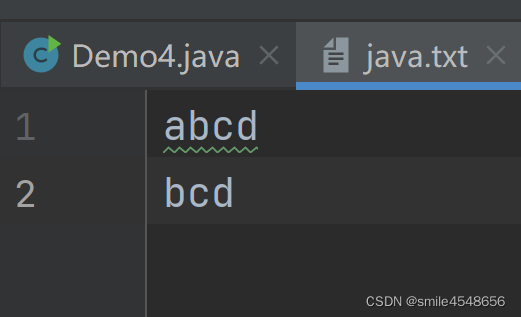Java——字符串和字符流的编码解码、字符流读写、字符缓冲流
一、字符串中的编码解码
1、编码
- byte[] getBytes():使用平台的默认字符集将该String编码为一系列字节,将结果存储在新的字节数组中
- byte[] getBytes(String charsetName):使用指定的字符集将该String编码为一系列字节,将结果存储在新的字节数组中
2、解码
- String(byte[] bytes):通过平台的默认字符集解码指定的字节数组来构造新的String
- String(byte[] bytes, String charsetName):通过指定的字符集解码指定的字节数组来构造新的String
import java.io.IOException;
import java.util.Arrays;
public class Demo1 {
public static void main(String[] args) throws IOException {
String str = "中国";
//使用默认字符集编码
byte[] bys = str.getBytes();
System.out.println(Arrays.toString(bys));
//使用默认字符集解码
String s = new String(bys);
System.out.println(s);
System.out.println("------------------");
//使用UTF-8字符集编码
byte[] bys1 = str.getBytes("UTF-8");
System.out.println(Arrays.toString(bys1));
//使用UTF-8字符集解码
String s1 = new String(bys, "UTF-8");
System.out.println(s1);
System.out.println("------------------");
//使用GBK字符集编码
byte[] bys2 = str.getBytes("GBK");
System.out.println(Arrays.toString(bys2));
//使用GBK字符集解码
String s2 = new String(bys2, "GBK");
System.out.println(s2);
}
}

二、字符流中的编码解码
1、字符流抽象基类
- Reader:字符输入流的抽象类
- Writer:字符输出流的抽象类
2、字符流中编码解码相关的两个类
- InputStreameReader
- OutputStreamWrite
3、示例
import java.io.*;
public class Demo2 {
public static void main(String[] args) throws IOException {
OutputStreamWriter osw = new OutputStreamWriter(new FileOutputStream("ZiFuLiu\\java.txt"));
osw.write("中国");
osw.close();
InputStreamReader isr = new InputStreamReader(new FileInputStream("ZiFuLiu\\java.txt"));
//一次读取一个字符数据
int ch;
while ((ch = isr.read()) != -1) {
System.out.print((char) ch);
}
isr.close();
}
}
三、字符流中写数据的5种方式
- void write(int c):写一个字符
使用时,需要使用flush()刷新流
import java.io.FileOutputStream;
import java.io.IOException;
import java.io.OutputStreamWriter;
public class Demo3 {
public static void main(String[] args) throws IOException {
OutputStreamWriter osw = new OutputStreamWriter(new FileOutputStream("ZiFuLiu\\java.txt"));
//void write(int c):写一个字符
osw.write(97);
osw.flush();
osw.write(98);
osw.flush();
//释放资源
osw.close();
}
}

-
void write(char[] cbuf):写入一个字符数组
-
void write(char[] cbuf, int off, int len):写入字符数组的一部分
public class Demo4 {
public static void main(String[] args) throws IOException {
OutputStreamWriter osw = new OutputStreamWriter(new FileOutputStream("ZiFuLiu\\java.txt"));
//void write(char[] cbuf):写入一个字符数组
char[] chs = {'a', 'b', 'c', 'd'};
osw.write(chs);
osw.write("\r\n");
//void write(char[] cbuf, int off, int len):写入字符数组的一部分
osw.write(chs, 1, 3);
osw.close();
}
}

- void write(String str):写一个字符串
- void write(String str, int off, int len):写一个字符串的一部分
import java.io.FileOutputStream;
import java.io.IOException;
import java.io.OutputStreamWriter;
public class Demo5 {
public static void main(String[] args) throws IOException {
OutputStreamWriter osw = new OutputStreamWriter(new FileOutputStream("ZiFuLiu\\java.txt"));
String s = "中国人";
osw.write(s);
osw.write("\r\n");
osw.write(s,1,1);
osw.close();
}
}

flush()和close()区别:
- flush():只刷新,使用完后还可以继续写入数据
- close():先刷新,再关闭。使用后不能继续写入数据
四、字符流读数据的2种方式
- int read():一次读一个字符数据
import java.io.FileInputStream;
import java.io.IOException;
import java.io.InputStreamReader;
public class Demo6 {
public static void main(String[] args) throws IOException {
InputStreamReader isr = new InputStreamReader(new FileInputStream("ZiFuLiu\\java.txt"));
//int read():一次读一个字符数据
int ch;
while ((ch = isr.read()) != -1) {
System.out.print((char) ch);
}
//释放资源
isr.close();
}
}
- int read(char[] cbuf):一次读一个字符数组数据
import java.io.FileInputStream;
import java.io.IOException;
import java.io.InputStreamReader;
public class Demo7 {
public static void main(String[] args) throws IOException {
InputStreamReader isr = new InputStreamReader(new FileInputStream("ZiFuLiu\\java.txt"));
//int read(char[] cbuf):一次读一个字符数组数据
char[] chs = new char[1024];
int len;
while ((len = isr.read(chs)) != -1) {
System.out.print(new String(chs, 0, len));
}
//释放资源
isr.close();
}
}
五、转换流对应的便捷子类
- FileReader(String fileName):用于读取字符文件的便捷类
- FileWriter(String fileName):用于写入字符文件的便捷类
//1. 根据数据源创建字符输入流对象
FileReader fr = new FileReader("ZiFuLiu\\abc.java");
//2. 根据目的地创建字符输出流对象
FileWriter fw = new FileWriter("ZiFuLiu\\copy.java");
六、字符缓冲流
1、概述
- BufferedWrite:将文本写入字符输出流,缓冲字符,以提供单个字符、数组和字符串的高效写入,可以指定缓冲区大小,或者接受默认大小。默认值足够大,可用于大多数用途
- BufferedReader:从字符输入流读取文本,缓冲字符,以提供字符、数组和行的高效读取,可以指定缓冲区大小,或者接受默认大小。默认值足够大,可用于大多数用途
2、构造方法
- BufferedWrite(Write out)
- BufferedReader(Reader in)
3、字符缓冲流读取数据示例
import java.io.*;
public class Demo8 {
public static void main(String[] args) throws IOException {
//写入
BufferedWriter bw = new BufferedWriter(new FileWriter("ZiFuLiu\\java.txt"));
bw.write("hello\r\n");
bw.write("world");
bw.close();
//读取
BufferedReader br = new BufferedReader(new FileReader("ZiFuLiu\\java.txt"));
//一次读取一个字符数据
int ch;
while ((ch = br.read()) != -1) {
System.out.print((char) ch);
}
//一次读取一个字符数组数据
char[] chs = new char[1024];
int len;
while ((len = br.read(chs)) != -1) {
System.out.print(new String(chs, 0, len));
}
br.close();
}
}
4、字符缓冲流特有功能
- BufferedWriter:
void newLine():写一行行分隔符,行分隔符字符串由系统属性定义 - BufferedReader:
public String readLine():读一行文字,结果包含行的内容的字符串,不包含任何行终止字符,如果流的结尾已经到达,则为null
import java.io.*;
public class Demo9 {
public static void main(String[] args) throws IOException {
BufferedWriter bw = new BufferedWriter(new FileWriter("ZiFuLiu\\java.txt"));
//写数据
for (int i = 0; i < 10; i++) {
bw.write("hello");
bw.newLine();
bw.flush();
}
//读数据
BufferedReader br = new BufferedReader(new FileReader("ZiFuLiu\\java.txt"));
String line;
while ((line = br.readLine()) != null) {
System.out.println(line);
}
//释放资源
bw.close();
br.close();
}
}





 本文详细讲解了Java中字符串的编码解码,包括getBytes()和String构造方法的应用,以及字符流的编码解码,重点介绍了Reader和Writer抽象基类,InputSteamReader和OutputStreamWriter的使用。此外,还探讨了字符流读写数据的不同方式,如write()的各种形式,以及flush()和close()的区别。最后,阐述了字符缓冲流BufferedWriter和BufferedReader的功能,包括newLine()和readLine()方法的使用。
本文详细讲解了Java中字符串的编码解码,包括getBytes()和String构造方法的应用,以及字符流的编码解码,重点介绍了Reader和Writer抽象基类,InputSteamReader和OutputStreamWriter的使用。此外,还探讨了字符流读写数据的不同方式,如write()的各种形式,以及flush()和close()的区别。最后,阐述了字符缓冲流BufferedWriter和BufferedReader的功能,包括newLine()和readLine()方法的使用。
















 1万+
1万+

 被折叠的 条评论
为什么被折叠?
被折叠的 条评论
为什么被折叠?








